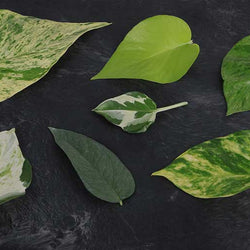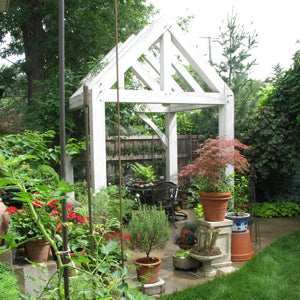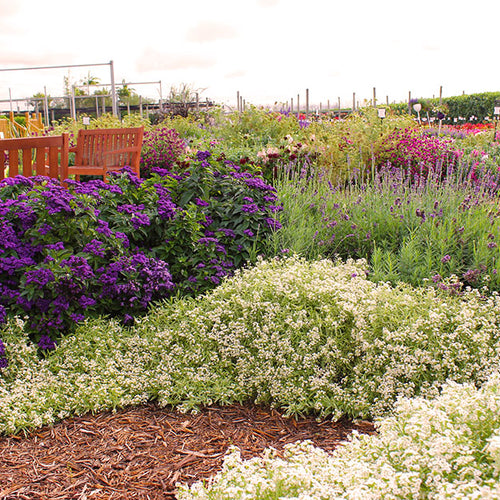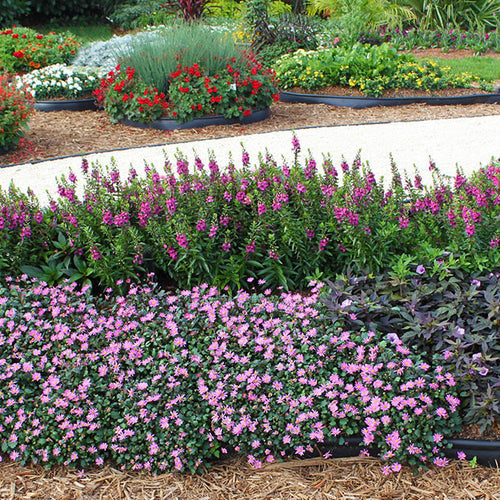
Choose a Mix of Plants
When designing with Desert Escape cacti and succulents, choose a mix of plants to provide a variety of rich colors and textures. Because most don't bloom appreciably, their appeal comes from their leaves.Silvery echeverias are great neutral plants that look good when planted with just about everything. They're a great place to start. Next, if you want height, look for a tall, upright accent such as this red African milk tree. Fill in with fun textures, including variegated agave and Campfire crassula (which shows off dramatic red or orange coloration when the weather is cool).

Create Layers
We layered Desert Escape varieties here to create a fun effect. You can do the same in your containers. It's easy! Simply choose plants of different heights. Red African milk tree is one of the tallest Desert Escape plants. Next to it, we planted a shorter candelabra cactus, then a variegated agave.For textural contrast, we added some flapjacks (which has leaf edges that echo the tone of the African milk tree), and complemented it with a variety of echeverias and an aloe.

Look for Fun Containers
Any vessel that will hold soil but still allow excess water to drain can be used for a cacti and succulents container garden. We love the architectural shape of this square concrete pot.The geometric appeal of Campfire crassula seemed like the perfect fit for the shape of the pot. We also loved the way the gray echeveria looks with it. We added in flapjacks for texture and red African Milk tree for height.

Play Off Your Container
If you're not sure where to start when designing a cacti and succulents container garden, take a look at the container. It might give you some clues.For example, we drew inspiration from the silvery-blue tone of this rustic Mexican pottery and used silvery echeverias. To contrast them, we added a purple-flushed echeveria and variegated baby jade (which has stems that accent the purple echeveria). Then for height we put in a variegated agave and beautiful candelabra cactus for height.

Add Mulch
Give your Desert Escape container gardens a more finished look by mulching the top of soil surface with pebbles, pea gravel, crushed glass, or another material.Here, we did that to help set off a pair of echeverias, a flapjacks, candelabra cactus, red African milk tree, and variegated baby jade.

Summer Care
One of our favorite things about Desert Escape cacti and succulents is that they're so easy to care for. If you live in an area that sees regular rainfall, you may not need to water them at all during the summer! During hot, dry weather, check the soil and be prepared to water once every week or two. Because these low-water plants can rot away if they're too wet, it's always best to feel the soil with your finger before watering again.Most cacti and succulents do best in full sun -- at least 6 to 8 hours of direct sun per day. You don't usually need to fertilize them or prune them -- the plants are that easy to grow!

Winter Care
If you live in a cold-winter area, you can treat Desert Escape plants just like petunias, geraniums, and your other favorite annuals. Or, if you want, you can try overwintering the plants.To keep the tender plants alive, bring them indoors to a bright spot before frosty temperatures arrive. The more light you can give them, the better they'll do -- so Desert Escape plants are perfect for growing near a glass patio door, large sunny window, or under a fluorescent light.
Indoors over winter, your Desert Escape containers may only need watering once every three or four weeks or so. Take care not to overwater them.
Looking for Other Container Gardening Ideas?
> Get more container-gardening ideas with Desert Escape> Learn more with our Container Gardening Guide
> Beautiful Cool-Season Container Garden Ideas
> Easy DIY: Make Your Own Planter!
> How to Plant a Container Garden
> Gorgeous Summer Container Combo Ideas
Get More on Xeriscaping!

















